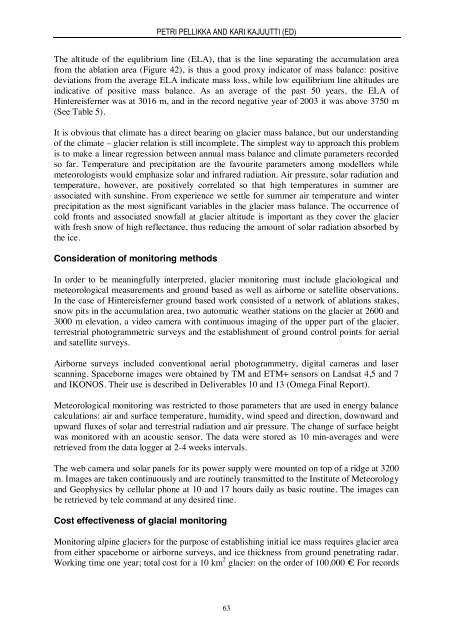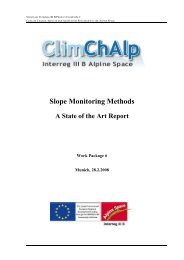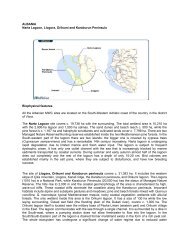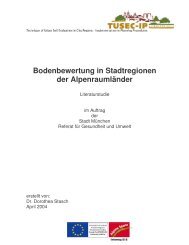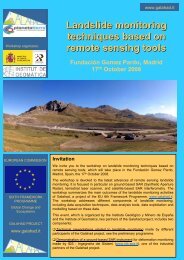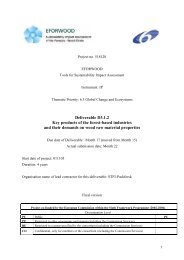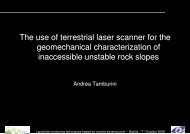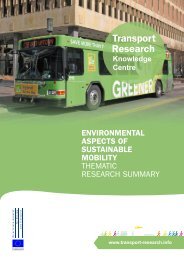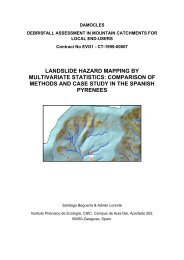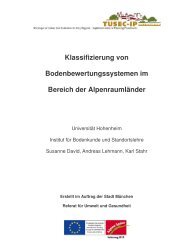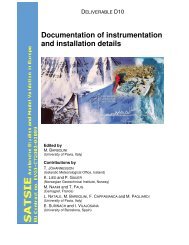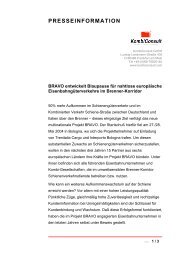1 Background - mountain.PROJECTS
1 Background - mountain.PROJECTS
1 Background - mountain.PROJECTS
You also want an ePaper? Increase the reach of your titles
YUMPU automatically turns print PDFs into web optimized ePapers that Google loves.
PETRI PELLIKKA AND KARI KAJUUTTI (ED)The altitude of the equlibrium line (ELA), that is the line separating the accumulation areafrom the ablation area (Figure 42), is thus a good proxy indicator of mass balance: positivedeviations from the average ELA indicate mass loss, while low equilibrium line altitudes areindicative of positive mass balance. As an average of the past 50 years, the ELA ofHintereisferner was at 3016 m, and in the record negative year of 2003 it was above 3750 m(See Table 5).It is obvious that climate has a direct bearing on glacier mass balance, but our understandingof the climate – glacier relation is still incomplete. The simplest way to approach this problemis to make a linear regression between annual mass balance and climate parameters recordedso far. Temperature and precipitation are the favourite parameters among modellers whilemeteorologists would emphasize solar and infrared radiation. Air pressure, solar radiation andtemperature, however, are positively correlated so that high temperatures in summer areassociated with sunshine. From experience we settle for summer air temperature and winterprecipitation as the most significant variables in the glacier mass balance. The occurrence ofcold fronts and associated snowfall at glacier altitude is important as they cover the glacierwith fresh snow of high reflectance, thus reducing the amount of solar radiation absorbed bythe ice.Consideration of monitoring methodsIn order to be meaningfully interpreted, glacier monitoring must include glaciological andmeteorological measurements and ground based as well as airborne or satellite observations.In the case of Hintereisferner ground based work consisted of a network of ablations stakes,snow pits in the accumulation area, two automatic weather stations on the glacier at 2600 and3000 m elevation, a video camera with continuous imaging of the upper part of the glacier,terrestrial photogrammetric surveys and the establishment of ground control points for aerialand satellite surveys.Airborne surveys included conventional aerial photogrammetry, digital cameras and laserscanning. Spaceborne images were obtained by TM and ETM+ sensors on Landsat 4,5 and 7and IKONOS. Their use is described in Deliverables 10 and 13 (Omega Final Report).Meteorological monitoring was restricted to those parameters that are used in energy balancecalculations: air and surface temperature, humidity, wind speed and direction, downward andupward fluxes of solar and terrestrial radiation and air pressure. The change of surface heightwas monitored with an acoustic sensor. The data were stored as 10 min-averages and wereretrieved from the data logger at 2-4 weeks intervals.The web camera and solar panels for its power supply were mounted on top of a ridge at 3200m. Images are taken continuously and are routinely transmitted to the Institute of Meteorologyand Geophysics by cellular phone at 10 and 17 hours daily as basic routine. The images canbe retrieved by tele command at any desired time.Cost effectiveness of glacial monitoringMonitoring alpine glaciers for the purpose of establishing initial ice mass requires glacier areafrom either spaceborne or airborne surveys, and ice thickness from ground penetrating radar.Working time one year; total cost for a 10 km 2 glacier: on the order of 100.000 €. For records63


